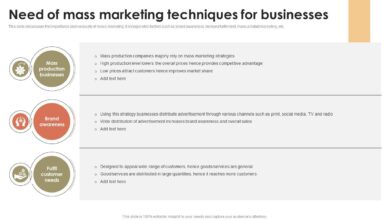
Launching and Marketing a New Website
Launching and marketing a new website is a thrilling yet daunting adventure! It’s like launching a rocket – you need a solid plan, precise execution, and a whole lot of hope it reaches orbit (and stays there!). From crafting the perfect pre-launch checklist to mastering the art of social media engagement, we’ll navigate the entire process, uncovering the secrets to a successful online launch.
This journey covers everything from defining your target audience and crafting killer content to monitoring your progress and making necessary tweaks along the way. Get ready for takeoff!
This post dives deep into the crucial steps involved in successfully launching a website. We’ll explore the strategic planning required, focusing on identifying your ideal customer, choosing the right marketing channels, and creating engaging content that resonates with your audience. We’ll also cover the technical aspects, from website testing to post-launch maintenance, ensuring your online presence is both robust and effective.
Think of this as your comprehensive guide to digital success.
Website Pre-Launch Checklist
Launching a new website is exciting, but without a meticulous pre-launch checklist, chaos can easily ensue. A well-structured plan ensures a smooth launch and minimizes potential problems. This checklist covers everything from the technical aspects to the marketing strategy, allowing you to stay organized and on track. Remember, thorough preparation is key to a successful website launch.
Website Pre-Launch Checklist Table
A comprehensive checklist is crucial for managing all pre-launch tasks. This table provides a framework for tracking progress across various areas. Regularly updating this table will keep you accountable and informed.
| Task | Status | Deadline | Assignee |
|---|---|---|---|
| Domain Name Registration | Complete | 2023-10-26 | John Doe |
| Website Design and Development | Complete | 2023-11-09 | Jane Doe |
| Content Creation (Pages, Blog Posts) | In Progress | 2023-11-16 | Marketing Team |
| Optimization | To Do | 2023-11-23 | Specialist |
| User Acceptance Testing (UAT) | To Do | 2023-11-30 | QA Team |
| Performance Testing | To Do | 2023-12-07 | Development Team |
| Security Testing | To Do | 2023-12-14 | Security Team |
| Marketing Materials Creation (Social Media Posts, Email Templates) | In Progress | 2023-12-21 | Marketing Team |
| Social Media Campaign Setup | To Do | 2023-12-28 | Social Media Manager |
| Website Deployment | To Do | 2024-01-04 | DevOps Team |
Website Launch Timeline Visualization
A visual timeline helps to understand the project’s progress at a glance. Imagine a Gantt chart, using a horizontal bar chart to represent each task. The x-axis represents time, and the y-axis represents the tasks. Each task is represented by a colored horizontal bar, with its length proportional to the duration of the task. The start and end dates are clearly marked.
Green bars indicate completed tasks, yellow bars indicate ongoing tasks, and red bars indicate overdue tasks. Milestones, such as the completion of development or the launch date, are highlighted with larger, differently shaped markers (e.g., diamonds). The overall aesthetic is clean, modern, and easy to read, utilizing a consistent color palette (greens, yellows, and reds for status) and clear font choices.
Importance of Thorough Testing Before Launch
Thorough testing is not an optional extra; it’s a critical step to ensure a successful launch. Untested websites risk encountering various issues, from minor glitches to major security vulnerabilities, leading to frustrated users and reputational damage. Three crucial testing types are:User Acceptance Testing (UAT) focuses on whether the website meets the needs and expectations of the end-users. This involves real users testing the website’s functionality and usability, providing feedback to identify areas for improvement.
For example, a clothing retailer might have potential customers test the website’s navigation, search functionality, and checkout process.Performance testing assesses the website’s speed, stability, and scalability under different load conditions. This helps identify bottlenecks and ensure the website can handle a large number of concurrent users without crashing. A large e-commerce site, for instance, might conduct performance testing to ensure the website remains responsive during peak shopping periods like Black Friday.Security testing identifies and mitigates potential vulnerabilities that could expose the website to cyberattacks.
This involves penetration testing, vulnerability scanning, and security audits to ensure the website is protected against common threats. A financial institution, for example, would need rigorous security testing to protect sensitive customer data. Failing to perform these tests adequately could lead to significant financial losses and reputational damage.
Launching and marketing a new website requires a multi-pronged approach. You need SEO, social media, and, crucially, video marketing. To really boost your visibility, check out this awesome guide on getting it on with youtube – it’s a game-changer for reaching a wider audience. Once you’ve mastered YouTube, you’ll see a significant impact on your website’s overall traffic and brand awareness.
Defining Target Audience and Marketing Strategy: Launching And Marketing A New Website
Launching a new handmade jewelry website requires a clear understanding of who we’re selling to and how we’ll reach them. This involves defining our target audience and crafting a robust marketing strategy that speaks directly to their needs and preferences. Ignoring this crucial step can lead to wasted resources and a lack of engagement.
Target Audience Segmentation
To effectively market our handmade jewelry, we’ll focus on three distinct target audience segments. Each segment has unique characteristics that will inform our marketing approach. A targeted approach allows for more efficient use of marketing resources and better conversion rates.
- Segment 1: The Young Professional (25-35 years old): This segment comprises individuals with established careers, disposable income, and a desire for stylish, high-quality accessories. They are digitally savvy, active on social media platforms like Instagram and Pinterest, and often make purchases online. They value unique, handcrafted items that reflect their personal style and are willing to pay a premium for quality and craftsmanship. They are interested in sustainable and ethically sourced products.
- Segment 2: The Millennial Mom (30-45 years old): This segment consists of mothers who appreciate beautiful jewelry but prioritize practicality and affordability. They are busy and value convenience, often shopping online during downtime. They are drawn to designs that are both elegant and functional, and appreciate brands that align with their family values. They are active on Facebook and may use parenting blogs and forums.
- Segment 3: The Mature Woman (55+ years old): This segment values classic elegance and timeless designs. They appreciate high-quality materials and craftsmanship. They may be less digitally inclined than younger segments, but are still active online, often through email and targeted advertising on sites they frequently visit. They may prefer more traditional shopping methods, but online presence is still important for reaching them. They are often influenced by word-of-mouth recommendations.
Marketing Strategy Comparison
We will employ a multi-channel marketing approach, combining content marketing, social media marketing, and email marketing. Each strategy offers unique strengths and weaknesses.
- Content Marketing: This strategy focuses on creating valuable and engaging content (blog posts, articles, videos) to attract and retain a clearly defined audience — and, ultimately, to drive profitable customer action. Strengths: Builds brand authority, attracts organic traffic, establishes expertise. Weaknesses: Requires consistent effort, can take time to see results, needs strong optimization.
- Social Media Marketing: This involves using social media platforms (Instagram, Facebook, Pinterest) to connect with target audiences, build brand awareness, and drive sales. Strengths: Wide reach, direct engagement with customers, cost-effective for certain platforms. Weaknesses: Requires consistent content creation, algorithms can limit organic reach, requires careful monitoring and response to comments.
- Email Marketing: This strategy uses email to nurture leads, promote new products, and build customer loyalty. Strengths: High conversion rates, allows for personalized messaging, cost-effective. Weaknesses: Requires building an email list, can be perceived as spam if not managed properly, requires adherence to email marketing best practices.
Comprehensive Marketing Plan
Our marketing plan will leverage the strengths of each strategy to target our three segments effectively.
| Target Segment | Marketing Tactic | Specific Actions | Budget Allocation |
|---|---|---|---|
| Young Professional | Instagram Marketing | High-quality product photography, influencer collaborations, targeted ads, Instagram Stories, Reels | $500/month |
| Young Professional | Content Marketing | Blog posts on jewelry styling, sustainable practices, behind-the-scenes glimpses of the creation process | $200/month (includes freelance writer) |
| Millennial Mom | Facebook Ads | Targeted ads showcasing family-friendly designs, promotions, and contests | $300/month |
| Millennial Mom | Email Marketing | Newsletter with exclusive offers, new product announcements, and styling tips | $100/month (email marketing platform subscription) |
| Mature Woman | Email Marketing | Personalized email campaigns featuring classic designs, highlighting quality and craftsmanship | $100/month |
| Mature Woman | Content Marketing (Blog & Website) | Articles focusing on the history of jewelry making, care tips, and timeless style advice | $200/month |
Website Launch and Promotion

Source: itdwebdesign.com
So, you’ve built your amazing website, defined your target audience, and crafted a killer marketing strategy. Now comes the exciting part: launching it into the world! This isn’t just about hitting the “publish” button; it’s about a coordinated effort to get your website seen, understood, and appreciated by your ideal customers. Let’s dive into the details of a successful launch and ongoing promotion.
Website Launch Process
The final stages before launch are crucial for a smooth and successful debut. A well-executed launch minimizes technical glitches and maximizes initial impact. This involves a meticulous approach to testing, deployment, and final checks.
- Final Testing: Before going live, conduct thorough testing across different browsers, devices (desktops, tablets, smartphones), and internet speeds. Check all links, forms, and functionalities to ensure a seamless user experience. Consider using browser developer tools to simulate different screen sizes and network conditions.
- Deployment: Once testing is complete, upload your website files to your hosting server. This process varies depending on your hosting provider, but generally involves using FTP or a control panel provided by your hosting service. Remember to back up your website files before deployment.
- DNS Propagation: After uploading, you need to update your domain name’s DNS records to point to your new website’s server. This process can take anywhere from a few minutes to several hours, depending on your DNS provider. Be patient and monitor the propagation to ensure your website is accessible.
- Final Checks: After DNS propagation, double-check your website’s accessibility, functionality, and overall appearance. Verify that all pages are loading correctly, and that your contact forms and other interactive elements are working as expected.
- Go Live!: Once everything is verified, you’re ready to officially launch your website. Announce the launch to your team and prepare for the influx of visitors.
Launch Day Social Media Campaign
A strong social media presence is essential for a successful website launch. This isn’t just about making a single announcement; it’s about building excitement and engagement leading up to and on the day of the launch.
Here’s a sample social media campaign plan:
- Pre-Launch (1 week before): Teaser posts and stories hinting at the new website’s features and benefits. Use engaging visuals and countdown timers. Example post: “Get ready! Something BIG is coming next week. #NewWebsiteLaunch #ComingSoon #WebsiteReveal”
- Launch Day (Morning): Official launch announcement with a captivating image or video showcasing the website’s key features. Include a clear call to action, such as “Visit our new website now! [website address] #WebsiteLaunch #GrandOpening #NewWebsite”
- Launch Day (Afternoon): Behind-the-scenes stories showing the team’s hard work and dedication. Humanize your brand and connect with your audience on a personal level. Example story: A short video showcasing the team celebrating the launch.
- Launch Day (Evening): A thank you post expressing gratitude to your audience for their support. Encourage engagement by asking questions about their initial impressions of the website. Example post: “Thank you for all the love and support! What’s your favorite feature of the new website? Let us know in the comments! #ThankYou #WebsiteLove #Feedback”
- Post-Launch (Following week): Share user-generated content (if any), run contests or giveaways, and continue to engage with your audience. Monitor comments and respond to questions promptly.
Post-Launch Website Monitoring and Maintenance
Launching your website is just the beginning. Ongoing monitoring and maintenance are vital for ensuring its continued success and performance. This includes regular updates, security checks, and performance optimization.
A robust post-launch plan includes:
- Analytics Tracking: Implement Google Analytics or a similar platform to track website traffic, user behavior, and other key metrics. This data provides valuable insights into what’s working and what needs improvement.
- Content Updates: Regularly update your website’s content with fresh, relevant information. This keeps your website engaging and helps improve your search engine rankings. Consider a content calendar to plan updates in advance.
- Security Monitoring: Regularly scan your website for vulnerabilities and implement security measures to protect against malware and hacking attempts. This might involve using a website security plugin or service.
- Performance Optimization: Monitor your website’s loading speed and optimize it for better performance. This includes optimizing images, minimizing HTTP requests, and using caching techniques.
- Backups: Regularly back up your website’s files and database to prevent data loss in case of unforeseen issues.
Measuring Website Success and Iteration

Source: digitalguider.com
Launching a website is only half the battle; understanding its performance and adapting accordingly is crucial for long-term success. This involves consistently monitoring key metrics, analyzing user behavior, and iteratively improving the website based on the data gathered. Without this ongoing process of measurement and refinement, your website’s potential will remain untapped.Tracking website performance requires a strategic approach, focusing on the right metrics to gain actionable insights.
This allows for informed decisions regarding design, content, and overall user experience. By regularly reviewing these metrics and adapting our strategy, we can ensure our website is continually optimized for maximum impact.
Key Performance Indicators (KPIs) for Website Success
Five key performance indicators are essential for understanding a website’s success. These metrics provide a comprehensive view of user engagement and overall effectiveness. Tracking these KPIs helps identify areas of strength and weakness, guiding future improvements.
- Website Traffic: This encompasses the total number of visitors to the website, broken down by sources (e.g., organic search, social media, paid advertising). High traffic generally indicates strong visibility and reach, but it’s crucial to analyze the quality of this traffic as well.
- Conversion Rate: This measures the percentage of visitors who complete a desired action, such as making a purchase, filling out a form, or subscribing to a newsletter. A high conversion rate signifies effective website design and persuasive content.
- Bounce Rate: This metric indicates the percentage of visitors who leave the website after viewing only one page. A high bounce rate often suggests issues with website design, content relevance, or site speed.
- Average Session Duration: This shows the average amount of time visitors spend on the website. A longer average session duration usually suggests engaging content and a positive user experience.
- Customer Satisfaction (CSAT): This can be measured through surveys, feedback forms, or social media monitoring. High CSAT scores indicate a positive user experience and brand perception.
Analyzing Website Traffic Data, Launching and marketing a new website
Analyzing website traffic data involves more than just looking at raw numbers. Understanding
- where* your traffic comes from,
- how* users interact with your website, and
- what* actions they take are vital. Tools like Google Analytics provide detailed reports on user behavior, allowing for in-depth analysis. For instance, heatmaps can visually show where users click and scroll on your pages, revealing areas of interest and potential issues. Analyzing this data reveals patterns in user behavior, allowing for targeted improvements.
By segmenting website traffic data (e.g., by demographics, geographic location, or source), you can gain a more nuanced understanding of your audience and tailor your content and design to better meet their needs. For example, if you notice a high bounce rate from users arriving via a specific social media platform, it might indicate a mismatch between your social media messaging and website content.
Website Iteration Plan
A structured plan for website iteration is crucial for continuous improvement. This plan should be based on the insights gained from analyzing website traffic data and user feedback. Regular reviews and updates are essential for maintaining a relevant and engaging website.
- Monthly Performance Review: Conduct a monthly review of all key KPIs, analyzing trends and identifying areas for improvement. This should include reviewing Google Analytics data, user feedback, and any A/B testing results.
- Quarterly Design and Content Updates: Based on the monthly reviews, implement quarterly updates to the website’s design and content. This could involve redesigning underperforming pages, updating outdated content, or adding new features based on user needs.
- Semi-Annual User Feedback Collection: Gather user feedback through surveys, feedback forms, and social media monitoring at least twice a year. Use this feedback to inform future design and content decisions.
- A/B Testing: Conduct A/B testing on different elements of the website (e.g., headlines, call-to-action buttons, page layouts) to determine what works best. This data-driven approach ensures continuous optimization.
- Annual Website Audit: Conduct a comprehensive audit of the website annually to assess its overall performance, identify any technical issues, and ensure alignment with business goals. This could involve a technical audit or a user experience audit.
Final Thoughts
So, there you have it – a whirlwind tour of launching and marketing a new website! Remember, success isn’t a destination, but a continuous journey of learning, adapting, and refining your approach. Don’t be afraid to experiment, analyze your results, and iterate based on what you discover. By consistently refining your strategies and staying attuned to your audience, you’ll build a thriving online presence that achieves its goals and beyond.
Now go forth and conquer the digital world!
Frequently Asked Questions
What’s the best way to choose a domain name?
Keep it short, memorable, relevant to your brand, and easy to spell. Check for availability across various platforms.
How much should I budget for website marketing?
It depends on your goals and scale. Start with a realistic budget and allocate funds strategically across different channels.
How often should I update my website content?
Regular updates are key. Aim for consistent content creation – blog posts, fresh images, updated product information – to keep your audience engaged.
What are some free tools for website analytics?
Google Analytics is a powerful, free tool offering comprehensive website traffic data and insights.
How can I measure the success of my website launch?
Track key metrics like website traffic, conversion rates, engagement levels, and customer acquisition cost.




